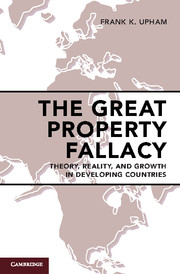Book contents
- Frontmatter
- Dedication
- Contents
- Preface
- Acknowledgments
- 1 Introduction
- 2 Physics Envy: Property Rights in Development Theory
- 3 Property and Markets: England and America
- 4 Property and Politics: Japan
- 5 Law and Development without the Law Part: China
- 6 Theory in Action: Cambodia
- 7 Property Rights and Social Change
- Index
2 - Physics Envy: Property Rights in Development Theory
Published online by Cambridge University Press: 19 January 2018
- Frontmatter
- Dedication
- Contents
- Preface
- Acknowledgments
- 1 Introduction
- 2 Physics Envy: Property Rights in Development Theory
- 3 Property and Markets: England and America
- 4 Property and Politics: Japan
- 5 Law and Development without the Law Part: China
- 6 Theory in Action: Cambodia
- 7 Property Rights and Social Change
- Index
Summary
The history of development economics begins with the end of World War II. The emergence of scores of newly independent nations coupled with the Cold War and the urgent need to gain those nations' political and military allegiance caught Western economists off guard. Up to that point, economics had been focused on market equilibrium among Western nations and was unconcerned with growth in our contemporary sense of poor nations getting rich. Economists in industrialized nations, as one development economics textbook puts it, “had no readily available conceptual apparatus with which to analyze the process of economic growth in largely agrarian societies characterized by the virtual absence of modern economic structures.” Nor did they have any knowledge, data, or experience in poor countries. What they did have was their own experience and familiarity with the economic history of the industrialized world, and that background dominated their approach to the rest of the world.
THE EMERGENCE OF NEO-INSTITUTIONAL ECONOMICS
Most prominent in economists' minds were two contemporaneous episodes of rapid economic growth: the forced march industrialization of Stalin's USSR and the Marshall Plan. Both were interpreted as accelerated capital accumulation stimulated by direct state intervention. Stalin transferred forced savings from the rural sector to industry; the Marshall Plan transferred capital and technology from the United States to postwar Europe. Western economists also had their own countries' histories, which all included the transformation from agrarian societies to industrial ones. Why should the new developing countries be any different? Further impetus for simplicity came from the nature of economics as an academic discipline that prized elegance, certainty, and universality, not detail, ambiguity, and difference. If the variety of the emerging nations demanded attention, it could be left to the anthropologists. Meanwhile the economists would discover, distill, and diffuse the universal imperatives for development, whatever the peculiarities of any specific country.
Out of this intellectual world emerged modernization theory, which dominated American foreign aid policy into the 1980s. Most prominent and closely identified with the Kennedy and Johnson administrations of the 1960s was Walter W. Rostow's stages-of-growth model of development, which combined a linear conception of development with faith in a mechanical connection between capital investment and growth.
- Type
- Chapter
- Information
- The Great Property FallacyTheory, Reality, and Growth in Developing Countries, pp. 11 - 33Publisher: Cambridge University PressPrint publication year: 2018

